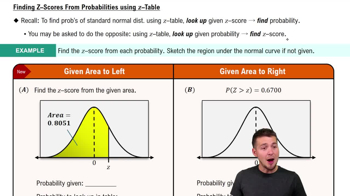Graphical Analysis In Exercises 17–22, find the indicated z-score(s) shown in the graph.
" style="" width="260">
 Verified step by step guidance
Verified step by step guidance Verified video answer for a similar problem:
Verified video answer for a similar problem:



 7:09m
7:09mMaster Probability From Given Z-Scores - TI-84 (CE) Calculator with a bite sized video explanation from Patrick
Start learning